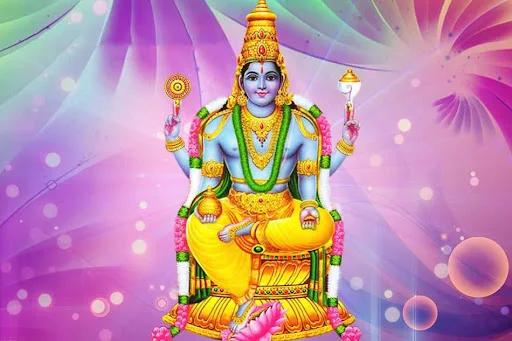Dhanvantari is an avatar of Vishnu in Hinduism. He appears in the Vedas and Puranas as the physician of the gods (devas), and the god of Ayurveda. It is common practice in Hinduism for worshipers to pray to Dhanvantari seeking his blessings for sound health for themselves and/or others, especially on Dhanteras. Bhagavata Purana states that Dhanvantari emerged from the Ocean of Milk and appeared with the pot of nectar during the story of the Samudra (or) Sagara Mathana whilst the ocean was being churned by the Devas and Asuras, using the Mandara mountain and the serpent Vasuki. The pot of Amrita was snatched by the Asuras, and after this event another avatar, Mohini, appears and takes the nectar back from the Asuras. It is also believed that Dhanvantari promulgated the practise of ayurveda. According to the ancient Sanskrit work Vishnudharamottara, Dhanvantari is a handsome individual and should usually be depicted with four hands, with one of them carrying Amrita, the ambrosia of god.
Dhanvantari is depicted as Vishnu with four hands, holding Shankha, Chakra, Jalauka (leech) and a pot containing rejuvenating nectar called amrita. He is often shown with a leech in his hand rather than the scriptures. His birthday is celebrated by the practitioners of Ayurveda every year, on Dhanteras, two days before Diwali, the Hindu festival of lights.
There are no permanent temples to Dhanvantari in Northern India. The reason is not yet known, but in Varanaseya Sanskrit Vishwavidyalaya, Varanasi, Uttar Pradesh state, one statue of Dhanvantari is present in the University museum. Two statues are at the headquarters of the Central Council for Research in Ayurveda and Siddha at New Delhi. There is another statue inside the Ayurveda Maha Sammelan office, Dhanawantari Bhawan at New Delhi and one statue of Dhanvantari is present at Mohyal Ashram in Haridwar.
There are a few dedicated temples to Dhanvantari in South India especially in Kerala and Tamil Nadu, where ayurveda is highly practised and patronised.
In Tamil Nadu, in the courtyard of Sri Ranganathaswamy Temple (Srirangam), there is a Dhanvantari shrine where daily worship of the deity is performed. In front of this temple there is an engraved stone believed to be from the 12th century. According to the writings on the stone, Garuda Vahana Bhattar, a great ayurvedic physician, established the statue inside the temple. A prasada orteertha, a herbal decoction, is given to the visitors. The shrine is the oldest Dhanvantari shrine in the state. Another Dhanvantari shrine is found in the second precinct of Varadaraja Perumal Temple in Kanchipuram.
Dhanvanthari temples in Kerala include:
Thevalakkadu Sree Dhanwanthari Temple, Kulasekharamangalam Post, Vaikom, Kottayam, Kerala.
Aanakkal Dhanwanthari Temple, Thaniyathukunnu, Thrissur
Sree Dhanwanthari Temple, Ramanathapuram, Coimbatore, Tamil Nadu.
Sree Dhanwanthari Temple , Maruthorvattom,Cherthala,Kerala State.
Mantras:
"Om Namo Bhagavate Maha SudharshanaVasudevaya Dhanvantaraye; Amrutha Kalasa Hasthaaya Sarva Bhaya Vinasaya Sarva Roka Nivaranaya Thri Lokya Pathaye Thri Lokya NithayeSri Maha Vishnu Swarupa Sri Dhanvantri SwarupaSri Sri Sri Aoushata Chakra Narayana Swaha"
Meaning: We pray to the God, who is known as Sudarshana Vasudev Dhanvantari. He holds the Kalasha full of nectar of immortality. Lord Dhanvantri removes all fears and removes all diseases. He is the well wisher and the preserver of the three worlds. Dhanvantari is like Lord Vishnu, empowered to heal the Jiva souls. We bow to the Lord of Ayurveda.
Hindus know Dhanwantari as the celestial healer and physician of the Gods. Lord Dhanwantari is regarded as the god of ayurvedic medicine in the Hindu religion. He is thereby the father of medical science. Lord Dhanwantari is an Avatar of Lord Maha Vishnu and is often depicted as dark complexioned strong man with a broad chest carrying a jug containing the nectar of immortality and wearing yellow clothes. According to Bhagavatam he was also garlanded with flowers and his fully decorated with various ornaments. He is also depicted in his four-armed form holding the Sudarsana Chakra and Conch in the upper right and lefts hands. In the other two hands he carries a pot containing the nectar of immortality and a herb. According to Hindu Puranas Lord Dhanvantari emerged from the ocean of milk with a pot of Amrit when it was churned by Gods and Demons. He is also called Sudhapani, which means 'carrying nectar in his hands'.
Dhanwantari is also said to have made an appearance in the Dwapar Yuga, two billion years ago. He appeared again as the son of King Dirghatamas of Kasi as the answer for his penance for a son. He is said to have prepared the samhitas on Ayurveda in eight divisions for the benefit of humanity. Lord Dhanvantari's teachings are recorded in the Agni Purana 279-289 as well as through the teachings of His disciple Susrutha.Dhanvantari is worshipped in Hindu households on Dhantrayodashi or Dhanteras which is the first day of Diwali. This day is considered very auspicious day to buy gold and silver jewelry, vehicles etc. Devotees worship Lord Dhanvantari to seek his blessings for sound health. He is also a much revered God of Ayurvedic Practitioners and Healers. Given below is his Maha Mantra which can be used to pray to Dhanvantari for improved or good health for self and for others.
Short Mantras of Lord Dhanvantri:
Om Dhanvantaraye Namah
Om Shri Dhanvantre Namah
Dhanwantri Maha Mantra
"Om Namo Bhagavate
Maha Sudharshana
Vasudevaya Dhanvantaraye;
Amrutha Kalasa Hasthaaya
Sarva Bhaya Vinasaya
Sarva Roka Nivaranaya
Thri Lokya Pathaye
Thri Lokya Nithaye
Sri Maha Vishnu Swarupa
Sri Dhanvantri Swarupa
Sri Sri Sri
Aoushata Chakra Narayana Swaha"
Dhanwantari Gayatri Mantras:
"Om tat purushaaya vidmahae
Amritha kalasa hastaaya dheemahi
Tanno Dhanvantri prasodayaat"
"Om aadivaidhyaaya vidmahae
Arogya anugrahaaya dheemahi
Tanno dhanvantri prasodayaat"







